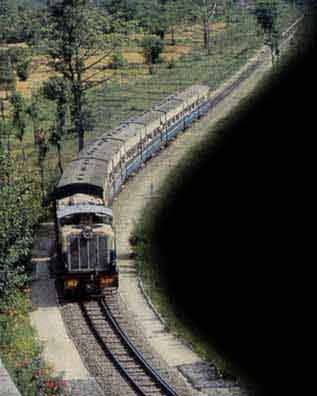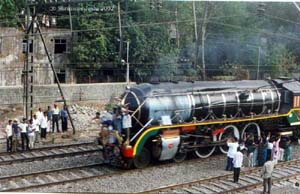|
Travelogues On The Right Tracks
|
|||||||||||||||
|
Travelogues • Toy Train • Bombay Local Rat Impressions • Delhi • Agra | ||||||||||||||
Before the departure of any train, especially a long distance express, any Indian station looks like a casbah in the Middle East. New Delhi station, prior to the departure of a Rajdhani Express, looks 10 times more crowded and just as chaotic. Passengers are running after coolies, who are trying to locate particular carriages; vendors are trotting up and down the platform trying to sell their wares, mineral water, fruits, newspapers and periodicals. Adding to this melee are the inevitable bhajiawallas and pooribhaajiwallas. To the uninitiated, Bhajia are onion or potato fritters; whereas a 'Bhaaji' is a cooked vegetable. Poori is a fried variety of Indian bread. The taste of the bhajias you get on railway stations is in a class of its own, and your experience of travelling on Indian Railways is not complete until you have tried them at least half a dozen times. Reservation charts are displayed on platforms and you always have a crowd around them with people at the back standing on tiptoe and craning their necks to find out which berth they have been allocated. The funny thing about these crowds is that they never completely disperse, even after the train has departed!
Her escort jumped on the moving train and pulled the emergency chain. By the time her entourage and her luggage had been loaded and good-byes with her escort exchanged, the poor conductor in our compartment was foaming in the mouth. She has remained etched in my memory. For a start, she hogged the berth that was allocated to me. Her voice made a foghorn seem melodious. The only thing louder than her voice was the combination of her violet sari and deep crimson lipstick. Although I was travelling long distance, I was an unhappy man that night.
The real fun of travelling begins as soon as you board. Your role changes from that of a spectator to that of a participant. Indians are not content to mutter a comment about the lateness of the train and then immerse themselves in the equivalent of the Telegraph crossword. They are far too social for that. As the train gathers speed, so does the banter. If you are travelling on an Indian train for the first time, it is difficult to believe that your fellow passengers are meeting each other for the first time. Not only is gossip exchanged, but also food and life stories. As everyone is expected to join in, you might as well do the same. Your fellow travellers are not averse to asking you direct and leading questions even if you put on the famous British reserve. This is not nosiness but friendliness. However, I can visualise a few raised eyebrows, when somebody you have only just met, asks you what your take-home pay is! Just as any conversation in a British pub always turns to football, any conversation among a group of Indians is inevitably going to involve a post-mortem of the state of Indian cricket. Once it is known that you are from Blighty, you should be prepared to field questions about English cricket. If you have no knowledge of cricket, the easiest way to get out of this predicament is to start talking about Indian politics. Start the ball rolling and then sit back. Indian politics is so complex a subject that it is easier to understand Einstein's Theory of Relativity. Unless you happen to be travelling on a Rajdhani Express, the train will make numerous stops on the way. Most of these stops are long enough to enable you to get off, stretch your legs, have a cup of chai (tea), and maybe a portion of bhajias. Even when the train leaves a station it does it at a sedate speed, so that stragglers or latecomers start boarding. There will always be somebody obligingly holding the door open for you. Having chai is an experience not to be missed. The Chaiwalla is an institution in himself, unlikely to be seen anywhere else in the world. Their strident cries of "Chai, garam chai"(tea, hot tea), can penetrate even well insulated air-conditioned carriages. Even at 2 o'clock in the morning, they parade up and down with undiminished spirit. Passengers themselves don't think anything of getting up from deep slumber to partake of this nectar. The typical way of making it is to boil the living daylights out of a mixture of water, milk, sugar and tea leaves, and when no more tannin can possibly be extracted, strain it off into small cups or glasses. On smaller stations, they use small disposable earthenware pots. After you finish, you throw the pot, usually between the platform and the train, where it disintegrates into smithereens. Dust to dust. However, the days of this most Indian of drinks may be numbered. On my last trip, I was served a lukewarm mixture of considerably watered down milk with a miserable looking tea bag floating in it. I suppose that is progress! On most long distance trains, you can order your meal from the carriage attendant. On trains without pantry cars, the attendant, after collecting the orders, gets off at the next station, sends a telegram to a station down the line; and lo and behold, your piping hot meal is waiting for you. That is Indian Railways at its efficient best.
SOME USEFUL TIPS The AC first class is the most comfortable and the most expensive, but is not available on all trains. The next most comfortable (and relatively inexpensive by European standards), is AC 2 tier. It is available on most long distance trains. This is the class I prefer. To alleviate the need for buying individual tickets for each journey, Indian Railways sell 'INDRAIL PASSES', valid for 7, 14, 21 and 30 days or 1,2 or 3 months. These entitle the traveller to UNLIMITED TRAVEL on the entire Indian Railways network, for the appropriate period. They may not save you a great deal of money, but in terms of time and hassle saved in not queuing up for reservations etc. they are priceless. In the U.K. they are available from S.D.E.L, at 103 Wembley Park Drive, Wembley Middx. HA9 8HG. who are the General Sales Agents in the U.K. for Indian Railways. Given 4 weeks notice, they can get you confirmed reservations for all your travels on the Indian Railways. This article will be incomplete, without at least, a brief mention of the proprietor of S.D.E.L., Dr. S. Dandapani. He is a walking, talking encyclopaedia on Indian Railways. If you are having problems in organising your itinerary, a telephone call to him will solve them straightaway. What this gentleman does not know about Indian Railways is probably not worth knowing. In India Indrail passes are available from: The Manager, International Tourist Bureau, New Delhi Railway Station, New Delhi. or Tourist Guide, Central Railway, Mumbai, Chhatrapati Shiwaji Railway Terminus, Mumbai and Tourist Guide, Western Railway, Upper Class Reservation Office, Church Gate, Mumbai.
|
|||||||||||||||
Editor: Romola Butalia (c) India Travelogue. All rights reserved. |
|||||||||||||||
 The best way to get to know a vast country like India is to traverse it by Indian Railways. They run 1300 trains and move more than 14 million people every day, over a route length of 67,000 kms. That is like moving the entire population of Australia every day! It is the most common form of national transport and certainly the most affordable. Major cities like Mumbai, Chennai (Madras), Calcutta, Trivandrum etc. are connected to Delhi, the national capital, by India's premier trains, collectively called 'Rajdhani Express'. They are the fastest on the network and consequently, always booked well in advance.
The best way to get to know a vast country like India is to traverse it by Indian Railways. They run 1300 trains and move more than 14 million people every day, over a route length of 67,000 kms. That is like moving the entire population of Australia every day! It is the most common form of national transport and certainly the most affordable. Major cities like Mumbai, Chennai (Madras), Calcutta, Trivandrum etc. are connected to Delhi, the national capital, by India's premier trains, collectively called 'Rajdhani Express'. They are the fastest on the network and consequently, always booked well in advance.

 Like many an old timer, I yearn for the good old days, when trains with evocative names like 'Frontier Mail', 'Flying Ranee', 'Grand Trunk Express', thundered through the nights trailing a mixture of steam and smoke. Little children in the train, defying parental commands to go to sleep, would peer out of the windows at the engine at some bend, and then end up in tears, due to a speck of soot in the eyes. Trains with romantic, magical names are still there. But those steaming, thundering nights are just a lingering memory.
Like many an old timer, I yearn for the good old days, when trains with evocative names like 'Frontier Mail', 'Flying Ranee', 'Grand Trunk Express', thundered through the nights trailing a mixture of steam and smoke. Little children in the train, defying parental commands to go to sleep, would peer out of the windows at the engine at some bend, and then end up in tears, due to a speck of soot in the eyes. Trains with romantic, magical names are still there. But those steaming, thundering nights are just a lingering memory.
 Observing the cameo develop during the arrival and departure of a train provides free and spontaneous entertainment. The departure is a unique ritual that involves the driver, the guard and the stationmaster. First the stationmaster blows a whistle and waves his green flag. Latecomers race up and down the platform, trying to get in wherever they can. Then the driver waves his green flag. The activity on the platform moves up one gear, from frantic to manic. The train is still stationary! Not to be outdone, the stationmaster waves his flag again. This charade repeats itself, until the guard has had enough of it. His patience snaps. There is an almighty blow on the whistle, a frenzy of flag-waving by all concerned and the train, almost reluctantly, pulls out of the station. This happens every time! I have travelled twice, with my sons to Agra. On both occasions our favourite pastime was to go to Agra Cantt. Station in the evening to witness the arrivals and departures, while gorging ourselves on the 'Bhajias'. Never mind the dinner or the lateness of the hour.
Observing the cameo develop during the arrival and departure of a train provides free and spontaneous entertainment. The departure is a unique ritual that involves the driver, the guard and the stationmaster. First the stationmaster blows a whistle and waves his green flag. Latecomers race up and down the platform, trying to get in wherever they can. Then the driver waves his green flag. The activity on the platform moves up one gear, from frantic to manic. The train is still stationary! Not to be outdone, the stationmaster waves his flag again. This charade repeats itself, until the guard has had enough of it. His patience snaps. There is an almighty blow on the whistle, a frenzy of flag-waving by all concerned and the train, almost reluctantly, pulls out of the station. This happens every time! I have travelled twice, with my sons to Agra. On both occasions our favourite pastime was to go to Agra Cantt. Station in the evening to witness the arrivals and departures, while gorging ourselves on the 'Bhajias'. Never mind the dinner or the lateness of the hour.